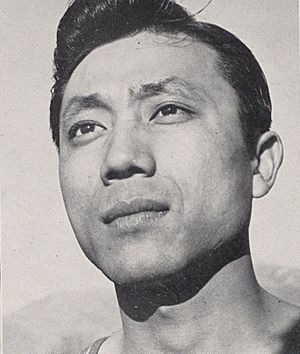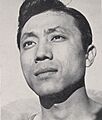Wataru Misaka facts for kids

Misaka in college with Utah in 1946–47
|
|
| No. 15 | |
|---|---|
| Point guard | |
| Personal information | |
| Born | December 21, 1923 Ogden, Utah |
| Nationality | American |
| Died | November 20, 2019 (aged 95) Salt Lake City, Utah |
| High school | Ogden (Ogden, Utah) |
| Listed height | 5 ft 7 in (1.70 m) |
| Listed weight | 150 lb (68 kg) |
| Career information | |
| College |
|
| NBA Draft | 1947 / Round: 7 / Pick: 61st overall |
| Selected by the New York Knicks | |
| Career history | |
| 1947 | New York Knicks |
| Career highlights and awards | |
|
|
| Wataru Misaka | |||||
|---|---|---|---|---|---|
| Japanese name | |||||
| Kanji | 三阪 亙 | ||||
|
|||||
Wataru Misaka (December 21, 1923 – November 20, 2019) was an American professional basketball player. He was a point guard who stood 5 feet 7 inches tall. Misaka made history by being the first non-white player in professional basketball. He was also the first player of Asian descent to play in the league. At that time, the league was called the Basketball Association of America (BAA), which later became the National Basketball Association (NBA).
Misaka played college basketball for the Utah Utes. He helped his team win two major championships. They won the 1944 NCAA championship and the 1947 NIT championship. Between these wins, he served in the United States Army. After college, Misaka played three games for the New York Knicks in the 1947–48 season.
Contents
Growing Up: Wat Misaka's Early Life
Misaka was born in Ogden, Utah. He was a Nisei, which means he was a second-generation Japanese American. His parents were Tatsuyo and Fusaichi Misaka. Wat grew up without much money, living with his two younger brothers. Their home was in the basement of his father's barber shop. It was in a tough area of 25th Street.
Life was hard for Japanese Americans during that time. They faced a lot of unfair treatment. Continuum magazine, from the University of Utah, said it was like "virtual apartheid". This means people were kept separate and treated differently because of their race. Japanese American children could not join many school activities. Instead, they played in their own baseball and basketball leagues. Misaka was sometimes refused service in restaurants. Neighbors would even cross the street to avoid him. Despite these challenges, Misaka loved sports and kept playing. He went to Ogden High School. There, he led his basketball team to a state championship in 1940. They also won a regional championship in 1941.
College Basketball Success
After high school, Misaka continued his studies. This was a difficult time for many Japanese Americans. Many were forced into special camps. Misaka attended Weber College. He helped the basketball team win two championships there. In 1942, Misaka was named the Most Valuable Player of the junior college postseason tournament. The next year, in 1943, he was named Weber College's athlete of the year.
Winning Championships with the Utah Utes
Misaka then went to the University of Utah. He joined their Utes basketball team. The young team had a great season in 1943–44, winning 18 games and losing only 3. They were invited to both the NCAA tournament and the National Invitation Tournament (NIT). The team chose the NIT first because it was more famous then. It also meant a trip to New York City.
The team lost their first game in the NIT to Kentucky. But they got a second chance! The Arkansas team had to drop out of the NCAA tournament. So, Utah was invited to play instead. Misaka's team took full advantage of this chance. They won the entire tournament! In the championship game, they beat Dartmouth 42–40 in overtime.
Two nights later, Misaka and his team played the NIT champions, St. John's. This was an exhibition game at Madison Square Garden. Utah won again, 43–36.
Serving His Country and More Wins
Misaka was later drafted into the army for World War II. He became a staff sergeant. After two years, he returned to the University of Utah. He rejoined the basketball team. The team went on to win their second national championship in four years. Because of their success, Utah was invited to the NIT championship tournament in New York again. The team won their first two games. Then, they beat Kentucky 49–45. This made them the champions of the 1947 NIT. Misaka played a key role, holding Kentucky's star player, Ralph Beard, to just one point.
On January 22, 2022, the Utah Utes honored Misaka's number 20 jersey. This means his jersey number will always be special to the team.
Playing Professionally: The NBA Pioneer
The New York Knicks chose Misaka in the 1947 BAA Draft. In 1947, he became the first non-Caucasian player in the BAA. This league later became the NBA. This was the same year that Jackie Robinson broke the baseball color line in baseball. The first African American player did not play in the NBA until 1950.
There were no big announcements or interviews when Misaka played his first game. He later said, "It wasn't a big thing. Nobody cared."
Misaka played in three games for the Knicks. He scored seven points during the 1947–48 season. He was cut from the team in the middle of the season. He thought it was because the Knicks had too many guards. Misaka said he did not feel any unfair treatment from his teammates or other players. He was close with future Hall-of-Famer Carl Braun during training camp.
Life After Basketball
Misaka decided not to play with the famous Harlem Globetrotters. Instead, he went back home to Utah. He earned a degree in engineering from the University of Utah. He remembered that the pay for a new basketball player and a new engineer was similar. He then started working as an electrical engineer in Salt Lake City. He and his wife, Kate, had two children. Wat Misaka passed away on November 20, 2019, in Salt Lake City. He was 95 years old.
Wat Misaka's Legacy
Wat Misaka left an important mark on sports history. In 1999, he was added to the Utah Sports Hall of Fame. In 2000, he was featured in a special exhibit. This exhibit, called More Than a Game: Sport in the Japanese American Community, was at the Japanese American National Museum in Los Angeles.
A documentary film about his life was released in 2008. It was called Transcending: The Wat Misaka Story. The film tells the story of his basketball career. It also highlights his important role as the first non-white player in the NBA.
Images for kids
See also
 In Spanish: Wataru Misaka para niños
In Spanish: Wataru Misaka para niños


